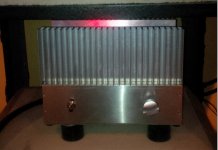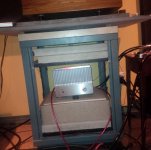Some numbers FYI :
-'ve rail voltage: 1.6 V / 10.5 Ohm = 152 ma
+'ve rail voltgage: 2.1 V/10 Ohm = 210 ma
Dale 10R.
DC offset after 5 minutes: L - 3.4 mv R - 0.7 mv.
When going for more hotrod, should I intentionally imbalance the resistors to equalize the +/- rail current?
If so, to get 600 ma, would the -'ve rail require 1.6/.6 = 2.67 Ohm, and the positive 3.5 Ohm?
-'ve rail voltage: 1.6 V / 10.5 Ohm = 152 ma
+'ve rail voltgage: 2.1 V/10 Ohm = 210 ma
Dale 10R.
DC offset after 5 minutes: L - 3.4 mv R - 0.7 mv.
When going for more hotrod, should I intentionally imbalance the resistors to equalize the +/- rail current?
If so, to get 600 ma, would the -'ve rail require 1.6/.6 = 2.67 Ohm, and the positive 3.5 Ohm?
Vgs will go higher with current. That will work to show less drop over Rset than now. Maybe -20%. The balancing difference between NMOS and PMOS Vgs should remain about the same in percentage though. So you can keep it for your calculating different values to bring currents closer. You will only need smaller resistors that you now think for specific currents. Still the gm does not change significantly if you are not getting exact results. Its just about ballpark steps.
Thanks! If the voltage drop decreases over Rset by Vdp (Voltage drop percentage), Vm is the currently measured drop across Rset and Iset the desired current, then estimates for Rset at Iset are obtained from Rset = Vm * (1-Vdp) /Iset
for Iset = 600 ma and Vdp= 0.20 this is Rset = 0.8*Vm/0.6
In my case, this gives Rsets of 2.8 for the and 2.13 for the +/- rails respectively.
If Vdp is 15% : Rset = 2.975 and 2.267 I guess 3R0 and 2R2 would be appropriate?
This could be tested with cheap resistors first before spending the "big money" on Caddock MP930 or a trimmer could be installed.... Has anyone tried a trimmer?
for Iset = 600 ma and Vdp= 0.20 this is Rset = 0.8*Vm/0.6
In my case, this gives Rsets of 2.8 for the and 2.13 for the +/- rails respectively.
If Vdp is 15% : Rset = 2.975 and 2.267 I guess 3R0 and 2R2 would be appropriate?
This could be tested with cheap resistors first before spending the "big money" on Caddock MP930 or a trimmer could be installed.... Has anyone tried a trimmer?
Yes use cheapos. Maybe 2R8 and 2R3. All those estimates are crude indicators. Each MOSFET has its own Vgs/Id curve tolerances. I guarantee you that prediction accuracy plays no audible role. Keep +/-10% for target and balance and you will be more than OK.
Thank you! I will forget about the trimmers and go buy some cement blocks.... given about 2 volts drop and 0.6 A => 5W is still ok
Last edited:
It is a bone stock TeaBag high perf. GB, and I enjoy it very much.
I was listening to an Ayre K1x with a Caddock as the gain resistor in single ended mode and frankly I like the DCB1 more. I am using a borrowed amp (McCormack DNA 500) , which is less sensitive than mine (2.25 V), so it runs at around 3:00 - no trouble with gain.
The sonic difference is that the Ayre sounds much softer with a little deeper sound stage, at the expense of clarity, and it does this for everything. It makes unlistenable albums very enjoyable -- eg. you cannot tell that Laurie Anderson 'Mr Heartbreak' was recorded in the '80s with the Ayre. It is obvious with the DCB1. The DCB1 shows far greater differences between recordings than the Ayre and is really starting to open up now.
According to my wife, who listens from upstairs, she also prefers the DCB1. I guess it is the overall clarity -- much more clean sounding than the Ayre. That's a big deal, as the Ayre is a very expensive player. Also, the Ayre phono stage vs Peter Daniel with OP27 loses again. That's what an $8K unit? IMO, it is trumped with this equipment.
It is really astonishing what can be acheived by paying attention to what is happening on this site. Thank you for helping make my stereo better in an affordable way!
---------------------
I got one each of 2.2, 2.4, 2.5 2.7 and 3.0 5W resistors. They measure out exactly as specified, but I don't know where to start.
I was listening to an Ayre K1x with a Caddock as the gain resistor in single ended mode and frankly I like the DCB1 more. I am using a borrowed amp (McCormack DNA 500) , which is less sensitive than mine (2.25 V), so it runs at around 3:00 - no trouble with gain.
The sonic difference is that the Ayre sounds much softer with a little deeper sound stage, at the expense of clarity, and it does this for everything. It makes unlistenable albums very enjoyable -- eg. you cannot tell that Laurie Anderson 'Mr Heartbreak' was recorded in the '80s with the Ayre. It is obvious with the DCB1. The DCB1 shows far greater differences between recordings than the Ayre and is really starting to open up now.
According to my wife, who listens from upstairs, she also prefers the DCB1. I guess it is the overall clarity -- much more clean sounding than the Ayre. That's a big deal, as the Ayre is a very expensive player. Also, the Ayre phono stage vs Peter Daniel with OP27 loses again. That's what an $8K unit? IMO, it is trumped with this equipment.
It is really astonishing what can be acheived by paying attention to what is happening on this site. Thank you for helping make my stereo better in an affordable way!
---------------------
I got one each of 2.2, 2.4, 2.5 2.7 and 3.0 5W resistors. They measure out exactly as specified, but I don't know where to start.
---------------------
I got one each of 2.2, 2.4, 2.5 2.7 and 3.0 5W resistors. They measure out exactly as specified, but I don't know where to start.
Start soldering likely combinations on some extension pins for easy exchange, check the currents, listen to find when enough is enough, finalize with thick film after in the know.
Cool account about the sonics. Expect more with Teflons instead of the Wimas. Some say more current is audibly better some say they hear zip. Lets see what you will hear.
Ah, extension pins.... that makes life a LOT simpler.
It's sounding really good now, which makes it hard to make change. Since yesterday, there is a remarkable improvement in image solidity and weight. Maybe, I should wait until this stabilizes before making any more changes and just relax.
The fuse issue and fixing the hum was stressful enough for one weekend!
It's sounding really good now, which makes it hard to make change. Since yesterday, there is a remarkable improvement in image solidity and weight. Maybe, I should wait until this stabilizes before making any more changes and just relax.
The fuse issue and fixing the hum was stressful enough for one weekend!
Here's a couple shots of it in the rack.
An externally hosted image should be here but it was not working when we last tested it.
Nice.
Thank you!
I have a different little problem now.... when the DAC (Benchmark USB Dac-1) is plugged into the input, I get a LOT of buzzing, and the music plays *very* quietly underneath. The same input rca's are used, they are just hooked up to the DAC instead....
The phono side has no noise at all. I don't get it....
I have a different little problem now.... when the DAC (Benchmark USB Dac-1) is plugged into the input, I get a LOT of buzzing, and the music plays *very* quietly underneath. The same input rca's are used, they are just hooked up to the DAC instead....
The phono side has no noise at all. I don't get it....
Thank you!
I have a different little problem now.... when the DAC (Benchmark USB Dac-1) is plugged into the input, I get a LOT of buzzing, and the music plays *very* quietly underneath. The same input rca's are used, they are just hooked up to the DAC instead....
The phono side has no noise at all. I don't get it....
A pot or attenuator with resistors ?
- Home
- Source & Line
- Analog Line Level
- Salas hotrodded blue DCB1 build

